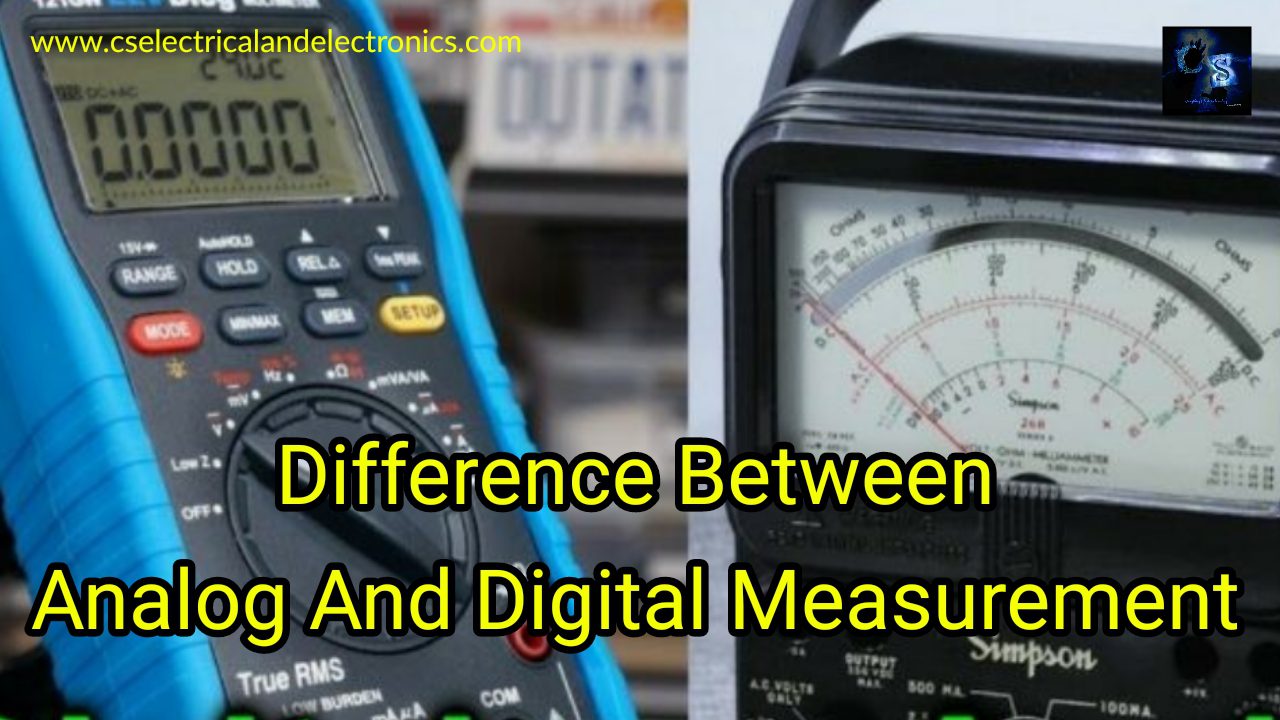Difference Between Analog And Digital Measurements
Hello guys, welcome back to my blog. In this article, I will discuss the difference between analog and digital measurements, what is an analog measurement, what is a digital measurement, etc.
If you need an article on some other topics then comment us below in the comment box. You can also catch me @ Instagram – Chetan Shidling.
Also, read:
- What Is A MATLAB, Applications, Alternatives, Advantages, Disadvantages
- What Is ABS Or Anti-Lock Braking System, Working, EBA, ESP, TCS.
- Top Free Online Course For Electrical And Electronics Engineers
Measurement is the activity of obtaining value and it compares the real value and obtained value. The measurements are classified into different types based on the type of instrument. In these instruments, nowadays the most used types are analog and digital. By using these instruments we measure the analog and digital quantities. Here is the difference between analog and digital measurements.
Analog And Digital Measurements
Analog Measurement
In the early decades, the most preferred measuring instrument was analog. If we need to measure the analog quantity for example to measure the electric current, there is a one moving coil meter which is having a pointer moving over a scale. The more the pointer varies up the scale the higher the current flows in the circuit. Similarly, all kinds of analog measuring devices worked in a similar way.
Digital measurement:
Nowadays all kinds of technologies or companies are using digital measuring instruments because it is having more advantages compared to other systems. In this measuring system whatever the input quantity, simply it converts the output in the form of digits. By this we get accurate information.
Differences between analog and digital measurements

| Analog | Digital |
| In this type of measurement, the output information is shown by pointer. | In this type of measurement, the output information is shown by digit. |
| In this type, presence of moving parts involved. | In this type there no presence of moving parts. |
| The possibility of human error exists. | It doesn’t exist any human error. |
| In this type of measurement, the instrument construction is like a simple, direct reding type and can perform in unfavorable conditions. | In this type, the construction of the instrument involves electronics and it requires proper environmental conditions. |
| The rate of change in output quantity is decided by seeing needle movement. | There is no change in the output quantity. |
| Less resolution. | More resolution. |
| It requires more time to observe the reading. If exact reading is required, the operator takes more time to guess the approximate quantity. | It requires less time to observe reading because it directly indicates the digit so, it takes less time to observe the reading. |
| There is no requirement of auxiliary power. | Require auxiliary source of power. |
| The accuracy of analog measurement is less. | The accuracy of digital measurement is more. |
| In this type of measurement, sensitivity is more. | In this type of measurement, sensitivity is less. |
| The analog instrument is cheap in cost. | The digital instrument is expansive. |
| In this type of instrument, there is no usage of batteries. | There is a requirement for batteries. |
| This type of measuring instrument is extremely portable. | These type of measuring instrument are not easily portable |
| There is a chance to occur the error because the output depends on the movement of the pointer. | There is no chance to occur the error because the output quantity is fixed. |
| There is no presence of LCD. | In this measuring instrument the output is displayed on LCD So, there is a presence of LCD. |
| In analog measurement, the reading of output quantity is difficult compared to digital measurement. | In digital measurement, the reading of output quantity is easy to read. |
| It is also used for high voltage limits. | It doesn’t use for the high voltage limits. If the voltage level increases beyond the limit, the meter will be damaged. |
| Examples: Speedometer of an automobile, fuel gauge, voltmeter, Ammeter, thermometer, etc… | Examples: Digital ammeters, Voltmeters, etc… |
I hope this article helps you to understand about the difference between analog and digital measurements. If you have any questions then comment below. Thank you for reading.
Also, read:
- 10 Tips To Maintain Battery For Long Life, Battery Maintainance
- 10 Tips To Save Electricity Bills, Save Money By Saving Electricity
- 100 (AI) Artificial Intelligence Applications In The Automotive Industry
- 100 + Electrical Engineering Projects For Students, Engineers
- 1000+ Control System Quiz, Top MCQ On Control System
- 1000+ Electrical Machines Quiz, Top MCQs On Electrical Machines
- 1000+ Electronics Projects For Engineers, Diploma, MTech Students
- 1000+ MATLAB Simulink Projects For MTech, Engineering Students
- 2024 Is About To End, Let’s Recall Electric Vehicles Launched In 2024
- 50 Advanced Level Interview Questions On CAPL Scripting
- 50 Tips To Save Electricity At Home, Shop, Industry, Office
- 50+ Question And Answer On The Substation, Electrical Question
- 500+ Embedded System Projects For Engineer, Diploma, MTech, PhD
- 500+ Matlab Simulink Projects Ideas For Engineers, MTech, Diploma
- 500+ Projects For Diploma Electrical, Electronics Student, Diploma Project
- 7 Ways EV Batteries Stay Safe From Thermal Runaway
- 8 Reasons Why EVs Can’t Fully Replace ICE Vehicles in India
- 8051 Microcontroller Timers, TCON Register, TMOD Register
- A Complete Guide To FlexRay Automotive Protocol
- Active Cell Balancing Using A Flyback Converter Simulation In Matlab Simulink

